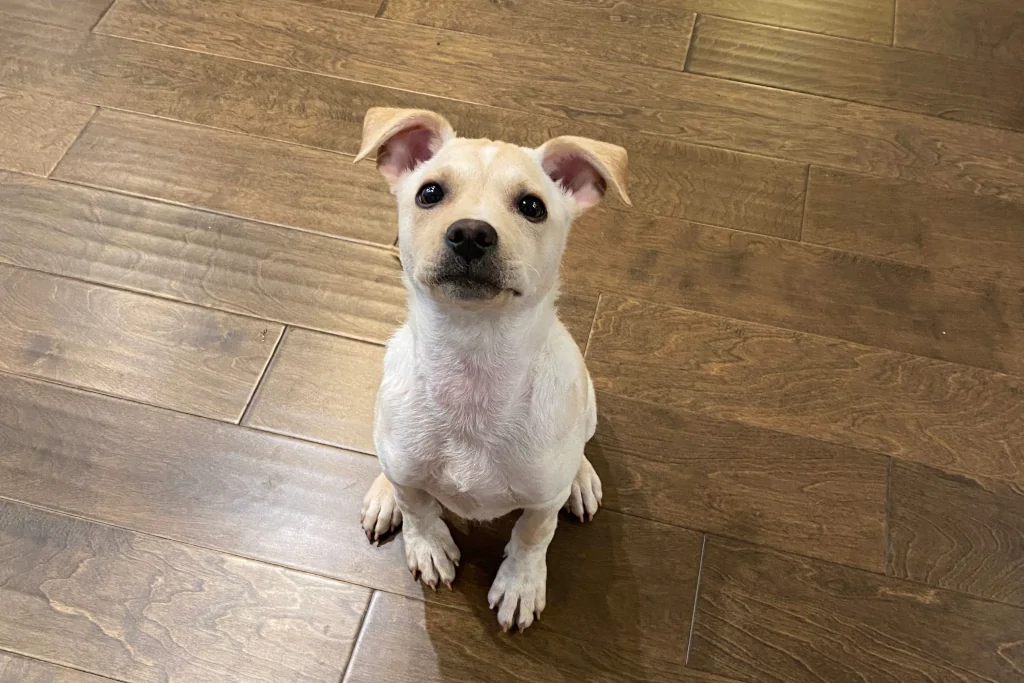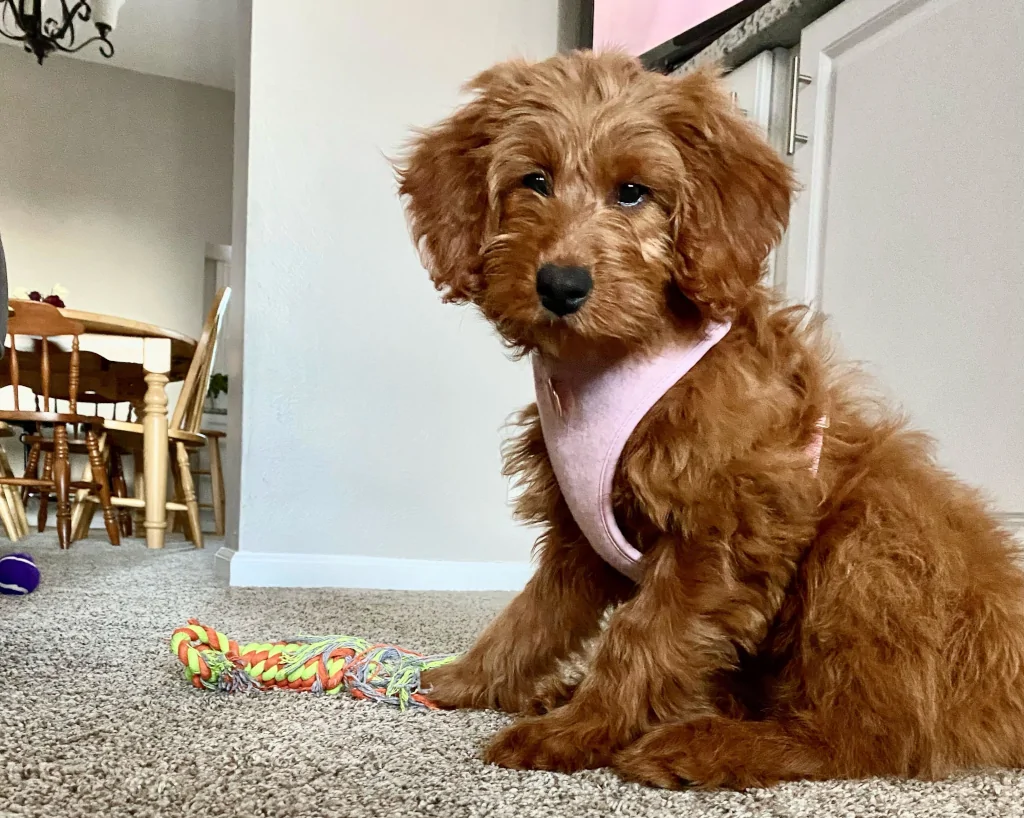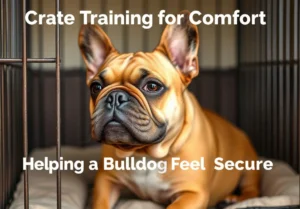Disclosure: We may earn a commission from helpful, relevant links in our content. No cost to you. See our privacy policy.
Potty training is a crucial milestone in a puppy’s life, but it can be a challenging and sometimes frustrating experience for pet owners.
A solid foundation in housebreaking and crate training not only saves your floors and furniture but also fosters a strong bond between you and your canine friend.
In this comprehensive guide, we’ll share valuable tips and tricks to make the process as smooth and stress-free as possible, while addressing common challenges and setting realistic expectations.

Why is Potty Training Important?
Potty training is essential for several reasons.
First, it helps maintain a clean and hygienic living environment for both you and your dog. Proper potty training reduces the chances of accidents, saving you time and effort spent on cleaning.
Second, it strengthens the bond between you and your pet by fostering mutual understanding and effective communication.
Finally, a well-trained dog will be more confident and well-adjusted, leading to a happier, more harmonious household.
Housebreaking vs. Crate Training: What’s the Difference?
Housebreaking and crate training are two distinct methods used to teach dogs appropriate potty habits.
Housebreaking involves teaching your dog to eliminate outdoors or in a designated area within your home, such as on puppy pads. This method requires patience, consistency, and a keen understanding of your dog’s natural instincts and cues.
Crate training, on the other hand, utilizes a dog’s denning instinct by providing a safe, comfortable space (the crate) where they feel secure and are less likely to eliminate.
As your dog becomes more comfortable in the crate, they will learn to hold their bladder and wait until they are let outside to relieve themselves. This method not only aids in potty training but also helps prevent destructive behavior and separation anxiety.
Both methods have their merits, and selecting the right approach for your dog depends on factors such as their age, temperament, and your lifestyle.
How to Housebreak Your Dog?
Housebreaking your dog requires patience, consistency, and a clear understanding of their needs. Here are some specific steps to guide you through the process:
- Establish a routine. Set a regular schedule for feeding, playtime, and potty breaks. Dogs thrive on routine, and a consistent schedule will help them understand when and where it’s appropriate to eliminate.
- Observe your dog’s signals. Pay close attention to your dog’s body language, such as sniffing, circling, or whining, which can indicate they need to go. When you notice these signals, immediately take them to their designated potty area.
- Choose a designated potty area. Select a specific location, either outdoors or indoors using puppy pads, for your dog to eliminate. Consistently taking your dog to the same spot will help them associate that area with going potty.
- Use a command or cue. When you take your dog to their potty area, use a consistent command or phrase like “go potty” or “do your business.” Over time, your dog will learn to associate this cue with the act of eliminating.
- Praise and reward. When your dog successfully eliminates in the designated area, immediately praise and reward them with a treat or affection. This positive reinforcement will help them understand they’ve done the right thing.
By following these steps and staying committed to the process, you’ll set your dog up for success and create a harmonious, accident-free living environment for both of you.

How to Crate Train Your Dog?
Crate training is an effective method for teaching your dog to view their crate as a safe, comfortable space while also promoting good behavior. Follow these steps for successful crate training:
- Choose the right crate. Select a crate that’s appropriately sized for your dog, allowing them to stand up, turn around, and lie down comfortably. A crate that’s too large can encourage them to use one end as a potty area. Our guide can help you choose a perfect crate.
- Introduce the crate gradually. Place the crate in a commonly used area of your home and encourage your dog to explore it by placing treats or toys inside. Keep the door open at first and let your dog enter and exit freely.
- Create a positive association. Make the crate a comfortable and inviting space by adding soft bedding, toys, and even a piece of your clothing. Providing these familiar items will help your dog feel more at ease in their new space.
- Establish a crate schedule. Start by crating your dog for short periods while you’re at home, gradually increasing the duration. Make sure to take your dog out for bathroom breaks and exercise before and after crate time.
- Reinforce good crate behavior. Reward your dog when they enter the crate willingly and remain calm inside. This positive reinforcement will encourage them to see the crate as a pleasant environment.
Try to follow these steps, and you will effectively crate train your dog and help them become comfortable and well-behaved in their new space.
Read more: Choosing the Right Training Toy for Your Dog
Common Potty Training Challenges and Solutions
Potty training can present its fair share of obstacles, but with patience and persistence, you can overcome these hurdles. Let’s explore some common challenges and their solutions:
Inconsistent progress.
If your dog seems to be making progress one day and regressing the next, reevaluate your routine. Make sure you’re sticking to a consistent schedule and being attentive to your dog’s signals.
Fear of the crate.
Some dogs may initially be hesitant to enter their crate. To help them feel more comfortable, gradually introduce the crate with positive reinforcement, such as treats and praise, and avoid forcing your dog inside.
Accidents in the house.
Accidents are a normal part of the potty training process. If they occur, clean up the mess immediately with an enzymatic cleaner and avoid scolding your dog. Instead, focus on reinforcing positive behavior and adjusting your supervision to prevent future accidents.
Refusing to eliminate outdoors.
If your dog is hesitant to go potty outside, try accompanying them on a leash or offering encouragement with a consistent command. Be patient, and reward them with praise and treats when they successfully eliminate outdoors.
Medical issues.
If your dog is struggling with potty training despite your best efforts, consult your veterinarian to rule out any underlying health issues, such as a urinary tract infection or gastrointestinal problem.
Try to address these common challenges with understanding and perseverance. By doing so, you’ll set your dog up for potty training success in the long-term.
Suggested read: Housebreaking and Potty Training aids
Tips for Consistency and Realistic Expectations
To achieve success in potty training, maintaining consistency and establishing realistic expectations are crucial. Here are some valuable tips to help you along the way:
- Stick to a schedule. Establish a regular feeding, playing, and potty break routine. Consistent schedules help your dog understand when it’s time to go outside, making the training process smoother.
- Supervise and confine when necessary. Keep a close eye on your dog, especially during the early stages of housebreaking. When you can’t actively supervise them, confine your dog to a small, safe area or use baby gates to restrict access to certain parts of the house.
- Clean up accidents promptly. Accidents will happen, but it’s essential to clean them up immediately using an enzymatic cleaner to remove any lingering odors. Dogs are more likely to eliminate in areas where they’ve done so before, and lingering odors can encourage repeat behavior.
- Be patient and adaptable. Potty training takes time, and each dog learns at their own pace. It’s essential to stay patient and adjust your approach as needed based on your dog’s progress.
- Praise and reward positive behavior. Reinforce your dog’s successful potty breaks with praise and treats. Positive reinforcement helps your dog associate outdoor elimination with rewards, making the behavior more likely to stick.
By following these tips and keeping realistic expectations in mind, you’ll be better equipped to navigate the potty training process with your furry friend.
Here’s a great video from Kikopup on potty training your puppy:
FAQs
What is the ideal age to start potty training a puppy?
The ideal age to start potty training a puppy is between 8 and 12 weeks old when they are more receptive to learning new behaviors and have better bladder control.
How to help my dog transition from using puppy pads to going outside?
To help your dog transition from using puppy pads to going outside, gradually move the pad closer to the door over several days, eventually placing it outside. Encourage and reward your dog for eliminating on the pad outdoors before removing the pad entirely.
How do I handle potty training accidents without scolding my dog?
Handle potty training accidents without scolding by calmly and promptly cleaning the mess with an enzymatic cleaner. Instead, focus on reinforcing positive behavior with praise and treats when your dog successfully eliminates in the designated area.
Can older dogs be successfully potty trained?
Older dogs can be successfully potty trained, though it may require more patience and consistency. Positive reinforcement and a structured routine are key to helping adult dogs learn new potty habits.
Alex, a passionate animal lover, has experience in training and understanding animal behavior. As a proud pet parent to two dogs and three cats, he founded AnimalReport.net to share insights from animal experts and expand his knowledge of the animal kingdom.




